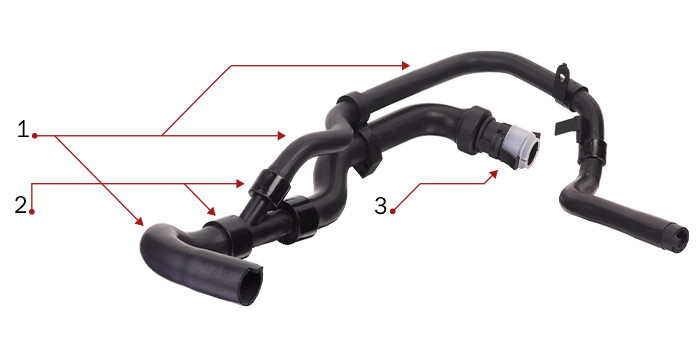Automotive cooling systems consist of many hoses and have grown increasingly complex in recent years, as more and more vehicles became turbocharged or were equipped with battery packs that needed cooling. These days, coolant hoses do more than just carry coolant from the radiator to the engine and back (as traditional, moulded coolant hoses do): modern 'modular' hoses branch off to various components, and they are typically outfitted with connectors and sensors. In this article, we’ll discuss the different ways in which these
modular hose assemblies, which are becoming more and more prevalent, can fail.
The most common causes of coolant hose failure
Regular hoses were commonly replaced when a vehicle was crashed and there was damage to the front (the radiator) because, in that case, the hose would often be damaged as well. But there are still more reasons why coolant hoses can fail, and with the newer modular hoses come new reasons for replacement as well.
Modular coolant hoses, like traditional, moulded coolant hoses, are exposed to coolant and to the hot and cold cycles underneath the bonnet. Over time, this may cause the rubber to soften, the hose to expand and the walls of the hose to become thinner, leading to small pinhole leaks in the rubber walls.
Specific to modular coolant hoses, however, and not leading to small leaks but to coolant pouring out of the hose assembly, are cracks in the plastic T-shaped or Y-shaped connectors that are used to make the hoses branch off in different directions. By virtue of where they are on the vehicle (exposed to hot and cold cycles, and to engine vibration), the plastic is going to become brittle over time, the connectors are going to flex and eventually break or crack, causing the whole assembly to fail.
The quick connectors attached to the end of modular coolant hoses for easy assembly (they allow mechanics to just snap the hose into place on the assembly line) may cause problems too. If you have a crashed car and only the radiator needs replacing, these quick connectors make it hard to reuse the hose, even if the latter is still in perfect condition, because they tend to get damaged when you pull them off. This means that, every time you need to replace a component that touches the hose, you will likely need a new hose assembly to go with it.

1: As with traditional curved hoses, high temperatures and prolonged exposure to fluids will cause the rubber to become soft, expand and lead to hose failure.
2: Plastic connectors become brittle and susceptible to breaking due to engine vibration and stresses of circulating coolant.
3: Quick connectors can fail when hoses are removed for general cooling system maintenance.
In addition, the sensors and other components may cause trouble. If you disconnect the sensor from the hose assembly, for maintenance for instance, it will likely be damaged. Or sensors may be damaged by water leaks, too. In short: anything that can damage an electrical connection can happen to hoses as well now.
And lastly, a lot of modular hoses have flow restrictors and directional valves inside of them to control the flow of the coolant. These can be stuck open or closed, so if the coolant is not getting to the radiator and to the engine, chances are something in the hose is locked.
Look beyond the upper and lower radiator hose!
Replacing a modular coolant hose is a
snap-on/off replacement that usually poses few problems, yet when troubleshooting, it is crucial to pay attention to more than the upper and lower radiator hoses. After all, heater hoses contain a lot of modular components as well, as do expansion tank hoses and radiator bleed hoses.